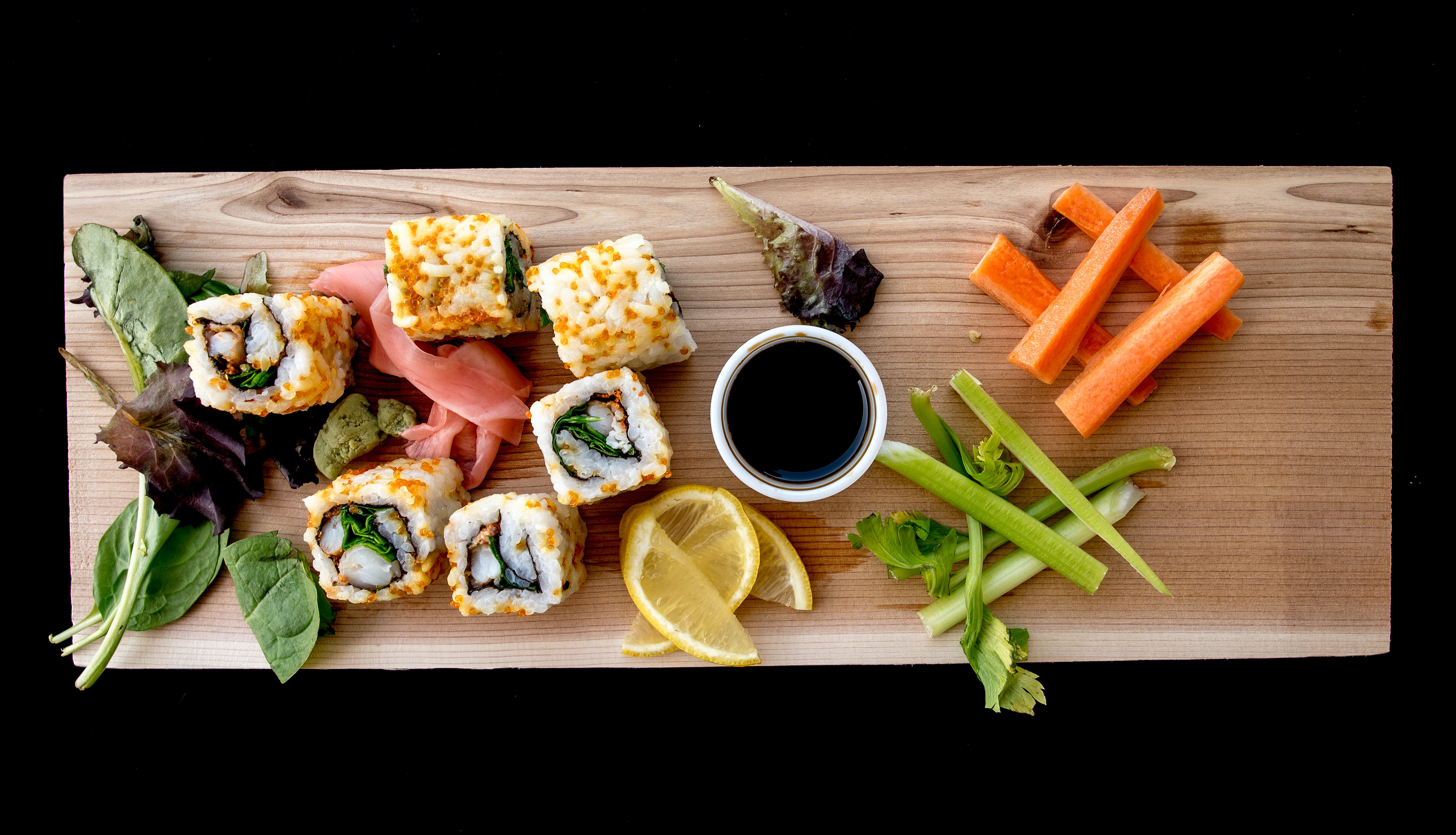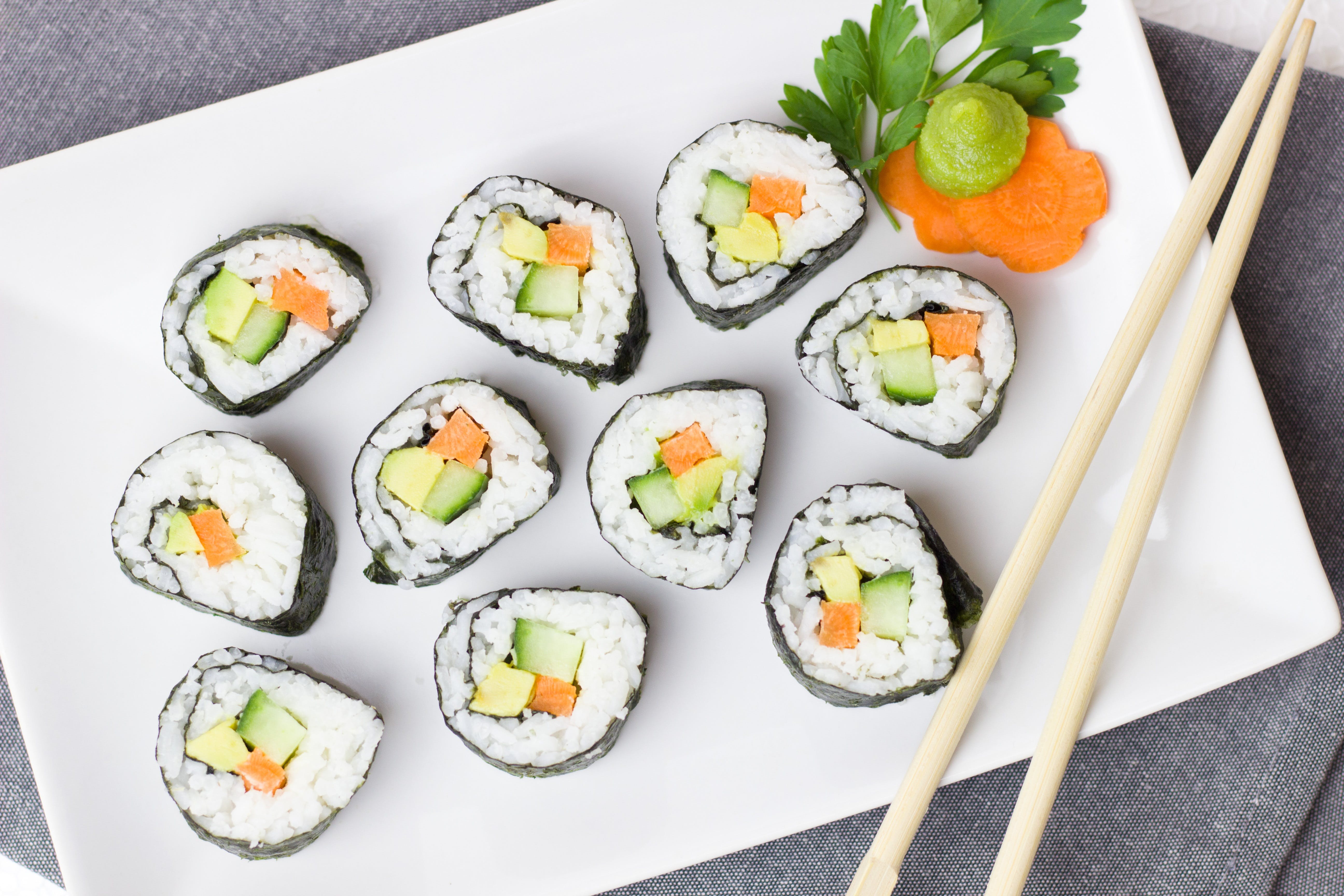What is a Kosher California Roll?

A California Roll is a popular type of sushi roll that originated in the United States, despite its name suggesting otherwise. This makizushi, or rolled sushi, is a fusion dish that typically includes imitation crab meat, avocado, and cucumber wrapped in seaweed and rice, then rolled in sesame seeds or tobiko (flying fish roe). The rice is placed on the outside of the roll, and it is usually served with pickled ginger, wasabi, and soy sauce. The California Roll is known for its light and refreshing flavors, making it a favorite choice for sushi beginners and enthusiasts alike. Its simplicity and familiar ingredients have made it a staple in sushi restaurants across the world. However, the origin of the California Roll and its unique combination of ingredients continues to be a point of interest and debate among food historians and sushi enthusiasts.
What Makes a California Roll Kosher?
A classic California Roll typically consists of kosher-certified ingredients such as sushi rice, nori (seaweed), imitation crab (made from kosher fish such as pollock), avocado, and cucumber. To ensure the kosher certification of these ingredients, look for symbols such as a K or U inside a circle on the packaging, indicating that a reliable kosher certification agency has verified the product.
When purchasing sushi rice, nori, and imitation crab, look for these ingredients at kosher grocery stores or in the kosher section of a regular grocery store. Make sure to check the packaging for the kosher certification symbol. Avocado and cucumber can usually be found at any grocery store, but it’s essential to check for individual kosher certification on these items as well. Additionally, if dining out, ensure that the sushi restaurant uses kosher-certified ingredients or has a kosher certification from a reliable agency.
By carefully checking for kosher certification symbols on each ingredient, you can ensure that all components of your California Roll are indeed kosher.
Ingredients
- Kosher imitation crab (usually made from white fish like Pollock)
- Sushi rice (cooked and seasoned with rice vinegar, sugar, and salt)
- Nori sheets (seaweed)
- Avocado, sliced
- Cucumber, sliced into thin strips
- Sesame seeds (optional)
- Soy sauce, wasabi, and pickled ginger for serving
Equipment
- Bamboo sushi rolling mat
- Sharp knife
- Bowl of water
Instructions
- Prepare the Sushi Rice: Cook the sushi rice according to package instructions. Season with a mix of rice vinegar, sugar, and a bit of salt. Let it cool to room temperature.
- Prepare the Fillings: Slice the avocado and cucumber into thin strips. Cut the Kosher imitation crab into lengthwise strips.
- Assemble the Roll:
- Lay a sheet of nori on the bamboo mat.
- Wet your fingers (to prevent sticking) and spread a thin layer of rice evenly over the nori, leaving about an inch of space at the top.
- Sprinkle sesame seeds over the rice (optional).
- Flip the nori sheet so that the rice is facing down on the mat.
- Add the Fillings:
- Place the avocado, cucumber, and imitation crab along the bottom edge of the nori sheet.
- Roll the Sushi:
- Lift the edge of the mat closest to you and roll it over the fillings, tucking the edge of the nori to start a roll.
- Gently press and shape the roll as you go, using the mat.
- Continue rolling until you reach the end of the nori. Use a bit of water to seal the edge.
- Cut the Roll:
- With a sharp, wet knife, cut the roll into 6-8 pieces. Clean the knife between cuts for a cleaner slice.
- Serve: Arrange the sushi on a plate and serve with soy sauce, wasabi, and pickled ginger.
Gather the Ingredients

Before you begin cooking or baking any recipe, it’s essential to gather all the necessary ingredients. This step is crucial in ensuring a smooth and efficient cooking process. Whether it’s gathering fresh produce, spices, or pantry staples, having everything you need on hand will make the cooking process much smoother. In this section, we will discuss the importance of gathering the right ingredients and provide tips for making sure you have everything you need before starting your recipe.
Sushi Rice
To make sushi rice, start by rinsing the sushi rice in a fine-mesh strainer under cold water until the water runs clear, removing extra starch. Then, cook the rice in a rice cooker or on the stovetop with the appropriate amount of water according to the package instructions.
While the rice is cooking, prepare the rice seasoning by combining rice vinegar, sugar, and salt in a small saucepan over low heat until the sugar and salt are dissolved. Once the rice is cooked, transfer it to a large bowl and slowly add the rice seasoning while fanning the rice with a sheet of paper. This helps to remove excess moisture and evenly distribute the seasoning.
Gently fold the rice and seasoning together using a wooden paddle or spoon, being careful not to mash the rice. Continue fanning and folding the rice until it reaches a glossy and sticky consistency.
Now your sushi rice is ready to be used to make various sushi rolls, nigiri, or sashimi. Enjoy your homemade sushi rice for a delicious and authentic sushi experience.
Nori Sheets
Nori sheets are a popular ingredient in Japanese cuisine, especially for making sushi rolls and nori snacks. There are two main types of nori sheets available: toasted and non-toasted.
Toasted nori sheets have a deep, smoky flavor and a crispy texture, while non-toasted nori sheets have a milder flavor and a slightly chewy texture. Toasting the nori sheets is important for enhancing their flavor and texture, especially when using them as a standalone snack.
To toast nori sheets, you can use either an oven or a gas burner. In the oven, preheat it to 275°F (135°C), place the nori sheets on a baking sheet, and toast them for 1-2 minutes until they become crispy. When toasting over a gas burner, simply hold the nori sheet with tongs and pass it quickly over the flame until it becomes crisp.
The toasting process brings out the natural flavors of the nori sheets and gives them a satisfying crunch, making them perfect for snacking. Whether you prefer the toasty, smoky flavor of toasted nori or the milder taste of non-toasted nori, both types are versatile and can be used in various recipes to add a unique umami flavor to your dishes.
Persian Cucumbers

Persian cucumbers are a versatile and healthy addition to any diet. Their mild flavor and crunchy texture make them perfect for eating raw in salads, sandwiches, or as a healthy snack. They are also great for pickling or adding to drinks, such as smoothies or infused water.
One of the benefits of Persian cucumbers is their thin skin, which makes them easy to eat without peeling. Their seedless nature also adds to their appeal, eliminating the need to scoop out seeds before using them in recipes.
When selecting Persian cucumbers, look for ones that are firm, bright green, and free of blemishes. Store them in the refrigerator to maintain their freshness and crispness. To prepare them for consumption, simply wash them under cold water and trim off the ends before slicing, dicing, or leaving them whole, depending on your preference.
In conclusion, Persian cucumbers offer a multitude of uses and benefits, from their mild flavor to their thin skin and seedless nature. By selecting, storing, and preparing them properly, you can fully enjoy their delicious and nutritious qualities.
Preparing the Rice
Before enjoying a delicious meal featuring rice, it’s important to ensure that the rice is properly prepared. From rinsing and soaking to different cooking methods, the way rice is prepared can greatly impact its taste and texture. To help you achieve perfectly cooked rice every time, we’ll explore the essential steps to preparing rice, including washing and soaking, cooking methods, and tips for getting that fluffy, flavorful result. Whether for a simple weeknight dinner or a special occasion, mastering the art of preparing rice is a fundamental skill that can elevate any meal. So, let’s dive into the world of rice preparation and discover the key techniques to make your rice dishes a success.
Rinse the Rice in Cold Water
To rinse the rice in cold water, start by placing the rice in the cooking pot. Cover the rice with fresh, cool water, and then swirl it around to remove any dust and bran. Then, carefully pour out the water, making sure to keep the rice in the pot. Repeat this process of adding cold water, swirling, and draining the water until the water runs clear or is mostly clear. This may take 3-4 rinses, depending on the type of rice. If desired, you can use a fine mesh sieve to catch any runaway rice while draining the water. Once the water runs clear, the rice is ready to be cooked. This rinsing process helps to remove excess starch and any impurities, resulting in fluffier and more separate grains of cooked rice. By following these steps to rinse the rice in cold water, you can ensure that your rice will cook up perfectly.
Soak the Rice for 30 Minutes
To prepare sushi rice, it is essential to begin by soaking it for 30 minutes. This allows the rice to absorb the necessary amount of water for optimal texture and consistency. To start, rinse the sushi rice in a fine mesh strainer until the water runs clear, ensuring that any excess starch is removed. Once rinsed, thoroughly drain the rice before transferring it to a bowl. Cover the rice with water and let it soak for 30 minutes, allowing it to fully absorb the water.
By following these steps to soak and prepare the sushi rice, you can ensure that it will cook evenly and result in the perfect texture for your sushi dishes. The soaking process is crucial for achieving the desired stickiness and flavor in sushi rice, making it an essential step in the overall sushi-making process. Remember to soak, rinse, drain, and allow the sushi rice to absorb the water for 30 minutes before proceeding with your sushi recipe for the best results.
Cook the Rice in a Rice Cooker or on a Stovetop

To cook sushi rice in a rice cooker, rinse the rice under cold water until the water runs clear. Then, add the rice and water to the rice cooker according to the rice cooker’s instructions. Close the lid and set it to cook. Once the rice cooker indicates that it’s done, let the rice sit for an additional 10-15 minutes to allow it to steam and finish cooking.
Alternatively, to cook the rice on the stovetop, use the same method of rinsing the rice and adding the appropriate amount of water to a pot. Bring the water to a boil, then reduce the heat to low, cover the pot, and let the rice simmer for about 20 minutes, or according to the package instructions. Once the rice is cooked, let it sit covered for an additional 10-15 minutes to allow it to steam.
Regardless of the cooking method used, the rice should be perfectly cooked and seasoned. This will ensure that it is ready to be used in all your sushi recipes. Following these steps will result in delicious sushi rice that is ready to be enjoyed with your favorite fillings and toppings.
Cool Down and Fluff up the Rice
To cool down and fluff up your rice for making sushi, start by spreading the freshly cooked rice out on a large baking sheet or tray. This will allow the rice to cool down to room temperature. It’s important to spread it out evenly to ensure that the rice cools down uniformly.
Once the rice has cooled down, it’s time to fluff it up. Gently use a rice paddle or fork to separate the grains of rice. This step is crucial to ensure that the rice is not only cooled down but also evenly fluffed up. Fluffing up the rice will help to aerate the grains and prevent them from sticking together when making sushi.
After the rice has been fluffed up, it is now ready to be used for making sushi. The cooled and fluffed-up rice will provide the perfect texture and consistency for creating delicious sushi rolls. So, make sure to cool down, spread out, and fluff up your rice to achieve the best results for your homemade sushi.
Making Sushi Vinegar Mixture for Flavoring the Rice

To make the sushi vinegar mixture for flavoring the rice, start by combining 1/2 cup of rice vinegar, 2 tablespoons of granulated sugar, and 1 teaspoon of kosher salt in a small saucepan over low heat. Stir the mixture continuously until the sugar and salt completely dissolve.
Once the mixture is ready, let it cool before pouring it over the cooked sushi rice. Spread the rice out in a shallow dish to maximize surface area. Drizzle the sushi vinegar over the rice, and then using a fan or a piece of cardboard, gently fan the rice while folding in the seasoning. This helps to mix the rice and seasoning evenly and also cools the rice down.
The sushi vinegar plays a crucial role in giving sushi rice its characteristic flavor and texture. It is important to use rice vinegar specifically made for sushi, as other types of vinegar may alter the taste. By following these steps, you can ensure that the rice is perfectly flavored and ready to be used for delicious and authentic sushi dishes.
Recommend0 recommendationsPublished in Recipes
Responses